Analyzing Statistics in Industrial-Organizational Psychology Research
VerifiedAdded on 2023/06/11
|17
|2183
|273
Report
AI Summary
This report delves into the significance of statistics within industrial-organizational psychology, emphasizing its role in data collection, analysis, and interpretation for informed decision-making and problem-solving in organizational settings. It highlights the importance of statistics in managing variability in diverse environments and its application in psychological research to understand human behavior and address organizational challenges. The report also discusses ethical considerations, diversity, and legal practices impacting organizational data, along with an overview of descriptive and inferential statistics, including examples of their application in workplace scenarios such as performance appraisal and training program evaluation. Furthermore, it examines different types of data measurements (nominal, ordinal, interval, and ratio) and their relevance in research, concluding with an analysis of how human resource practices affect organizational performance, supported by statistical testing and hypothesis evaluation. Find more solved assignments on Desklib.
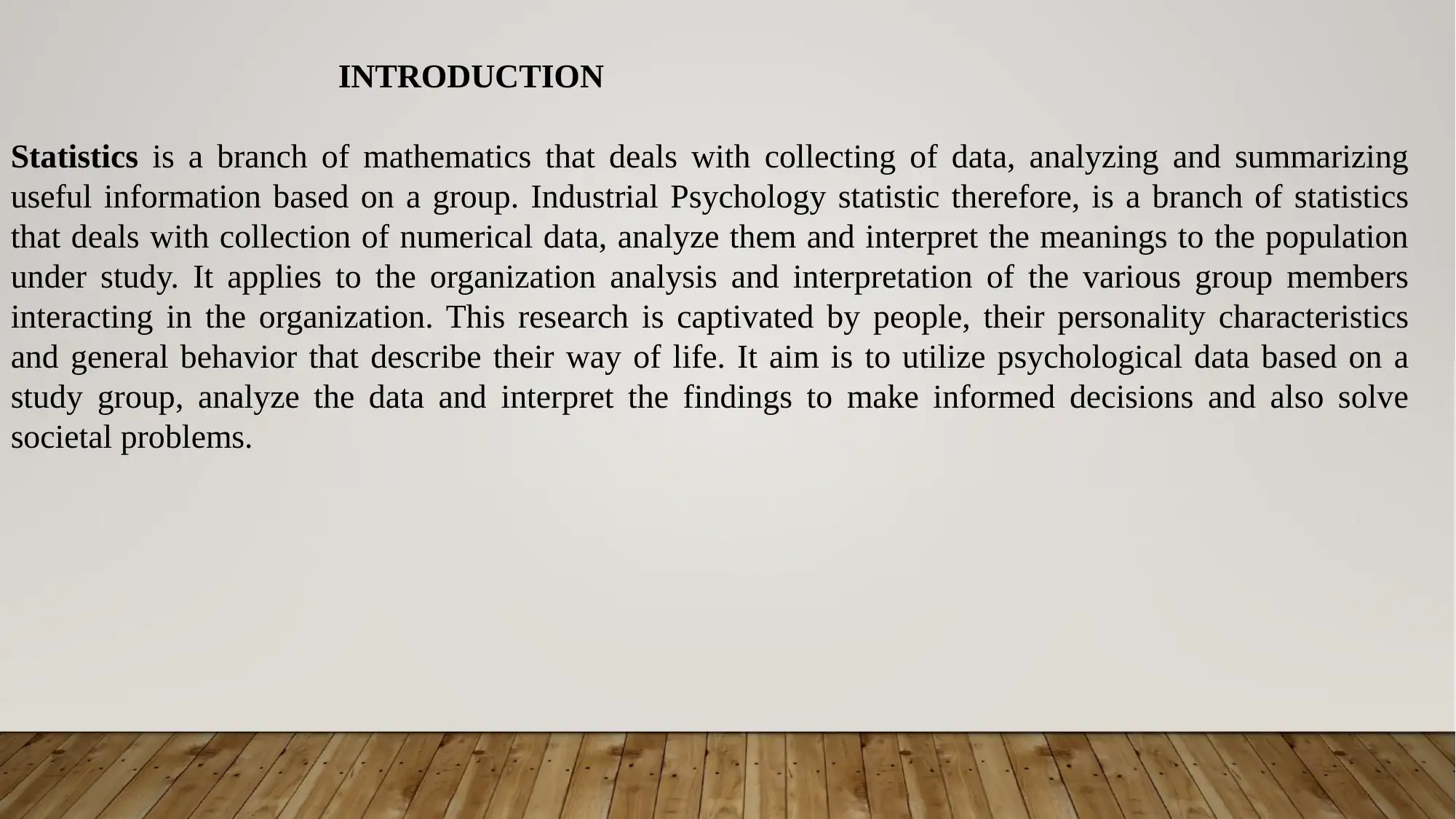
INTRODUCTION
Statistics is a branch of mathematics that deals with collecting of data, analyzing and summarizing
useful information based on a group. Industrial Psychology statistic therefore, is a branch of statistics
that deals with collection of numerical data, analyze them and interpret the meanings to the population
under study. It applies to the organization analysis and interpretation of the various group members
interacting in the organization. This research is captivated by people, their personality characteristics
and general behavior that describe their way of life. It aim is to utilize psychological data based on a
study group, analyze the data and interpret the findings to make informed decisions and also solve
societal problems.
Statistics is a branch of mathematics that deals with collecting of data, analyzing and summarizing
useful information based on a group. Industrial Psychology statistic therefore, is a branch of statistics
that deals with collection of numerical data, analyze them and interpret the meanings to the population
under study. It applies to the organization analysis and interpretation of the various group members
interacting in the organization. This research is captivated by people, their personality characteristics
and general behavior that describe their way of life. It aim is to utilize psychological data based on a
study group, analyze the data and interpret the findings to make informed decisions and also solve
societal problems.
Secure Best Marks with AI Grader
Need help grading? Try our AI Grader for instant feedback on your assignments.
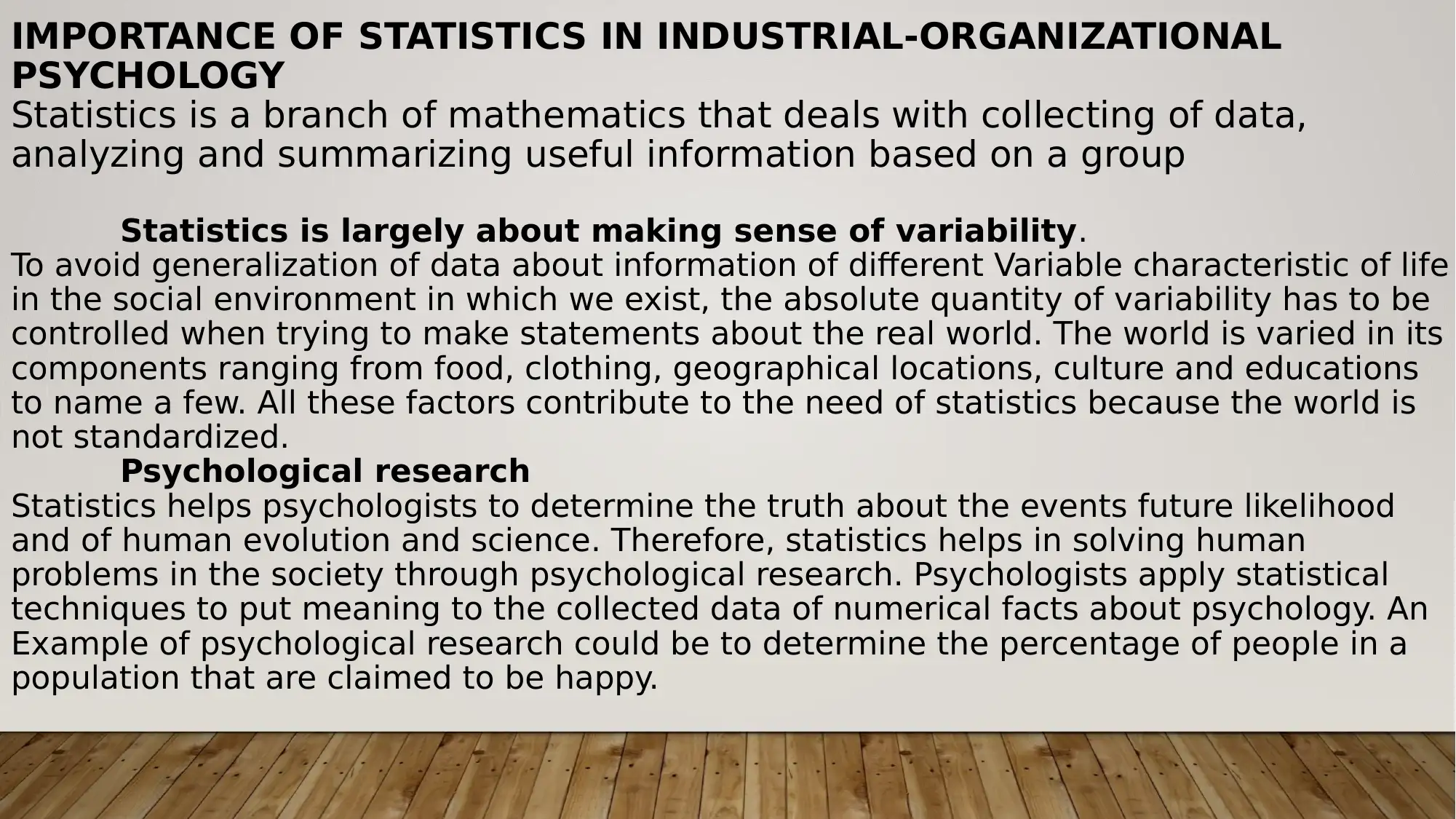
IMPORTANCE OF STATISTICS IN INDUSTRIAL-ORGANIZATIONAL
PSYCHOLOGY
Statistics is a branch of mathematics that deals with collecting of data,
analyzing and summarizing useful information based on a group
Statistics is largely about making sense of variability.
To avoid generalization of data about information of different Variable characteristic of life
in the social environment in which we exist, the absolute quantity of variability has to be
controlled when trying to make statements about the real world. The world is varied in its
components ranging from food, clothing, geographical locations, culture and educations
to name a few. All these factors contribute to the need of statistics because the world is
not standardized.
Psychological research
Statistics helps psychologists to determine the truth about the events future likelihood
and of human evolution and science. Therefore, statistics helps in solving human
problems in the society through psychological research. Psychologists apply statistical
techniques to put meaning to the collected data of numerical facts about psychology. An
Example of psychological research could be to determine the percentage of people in a
population that are claimed to be happy.
PSYCHOLOGY
Statistics is a branch of mathematics that deals with collecting of data,
analyzing and summarizing useful information based on a group
Statistics is largely about making sense of variability.
To avoid generalization of data about information of different Variable characteristic of life
in the social environment in which we exist, the absolute quantity of variability has to be
controlled when trying to make statements about the real world. The world is varied in its
components ranging from food, clothing, geographical locations, culture and educations
to name a few. All these factors contribute to the need of statistics because the world is
not standardized.
Psychological research
Statistics helps psychologists to determine the truth about the events future likelihood
and of human evolution and science. Therefore, statistics helps in solving human
problems in the society through psychological research. Psychologists apply statistical
techniques to put meaning to the collected data of numerical facts about psychology. An
Example of psychological research could be to determine the percentage of people in a
population that are claimed to be happy.
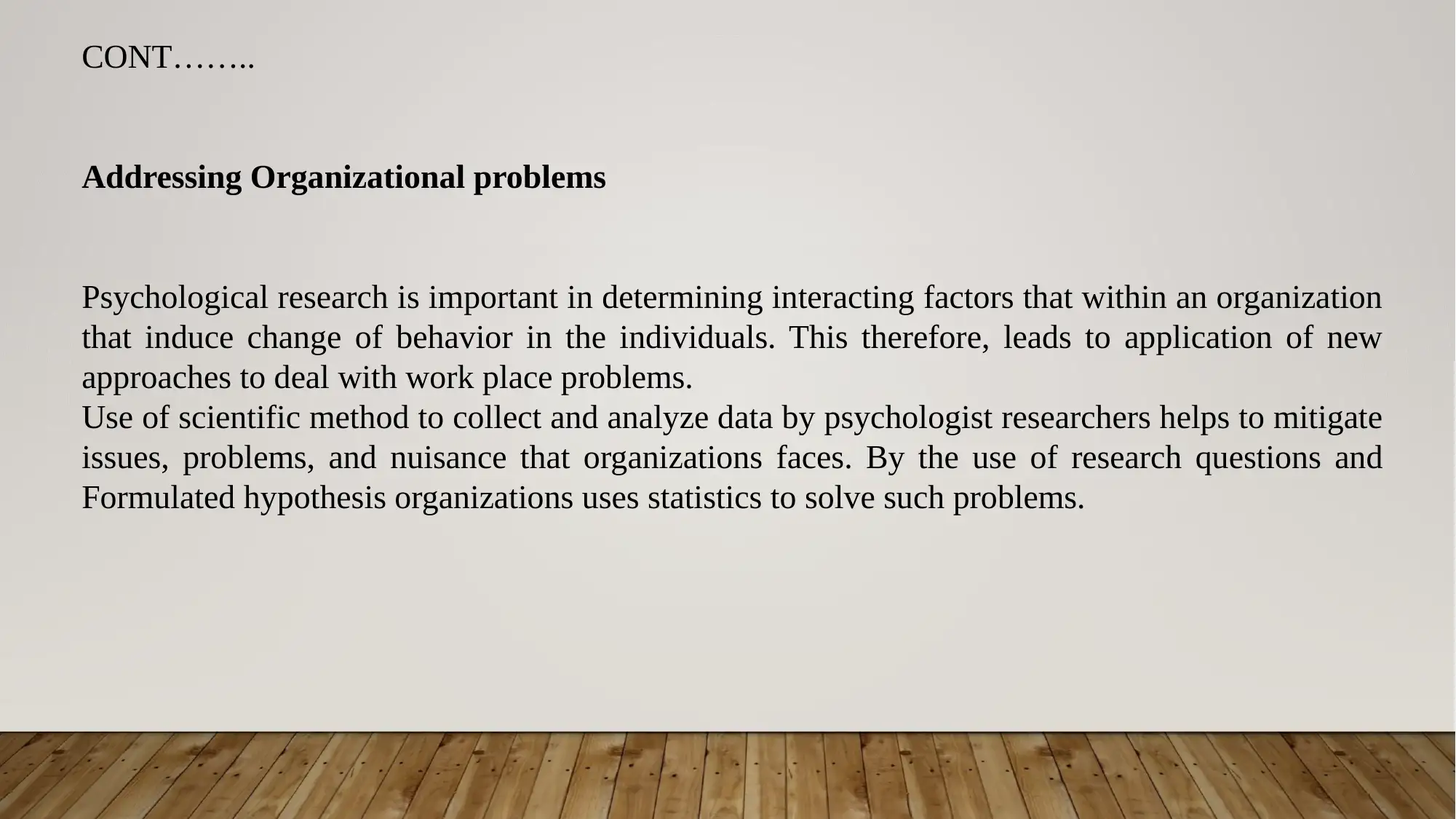
CONT……..
Addressing Organizational problems
Psychological research is important in determining interacting factors that within an organization
that induce change of behavior in the individuals. This therefore, leads to application of new
approaches to deal with work place problems.
Use of scientific method to collect and analyze data by psychologist researchers helps to mitigate
issues, problems, and nuisance that organizations faces. By the use of research questions and
Formulated hypothesis organizations uses statistics to solve such problems.
Addressing Organizational problems
Psychological research is important in determining interacting factors that within an organization
that induce change of behavior in the individuals. This therefore, leads to application of new
approaches to deal with work place problems.
Use of scientific method to collect and analyze data by psychologist researchers helps to mitigate
issues, problems, and nuisance that organizations faces. By the use of research questions and
Formulated hypothesis organizations uses statistics to solve such problems.

ETHICS, DIVERSITY, AND LEGAL PRACTICES IN A WORKING
ORGANIZATIONAL
The impact of these Ethics, diversity and legal practices in numerous studies are found to have impact
on organizational data. The recent rebellion in psychology is led by qualitative research methodologists
as an approach that is much more prominent in other behavioral and social sciences, such as
communication. (Willig & Stainton-Rogers, 2008). The qualitative research methods, is developed by
cultural anthropology and it involve lengthy interviews or observations of some few respondents. The
researchers decision in an event taking place is to remember, record, and pursue through more questions
or observations the ultimate goal of carrying out the research. The researcher’s mind is the main
instrument since this approach advocates that the mind can only find the vital associations among the
many groups of events arising in the respondent’s speech. Steele and his colleagues research on the
threats of stereotypes underlined the risk of conforming self characteristics about a group that an
individual belongs to. Steele argues that it is no so much that you have internalized a negative attitude
about yourself, but that certain situations create the threat.
ORGANIZATIONAL
The impact of these Ethics, diversity and legal practices in numerous studies are found to have impact
on organizational data. The recent rebellion in psychology is led by qualitative research methodologists
as an approach that is much more prominent in other behavioral and social sciences, such as
communication. (Willig & Stainton-Rogers, 2008). The qualitative research methods, is developed by
cultural anthropology and it involve lengthy interviews or observations of some few respondents. The
researchers decision in an event taking place is to remember, record, and pursue through more questions
or observations the ultimate goal of carrying out the research. The researcher’s mind is the main
instrument since this approach advocates that the mind can only find the vital associations among the
many groups of events arising in the respondent’s speech. Steele and his colleagues research on the
threats of stereotypes underlined the risk of conforming self characteristics about a group that an
individual belongs to. Steele argues that it is no so much that you have internalized a negative attitude
about yourself, but that certain situations create the threat.
Secure Best Marks with AI Grader
Need help grading? Try our AI Grader for instant feedback on your assignments.
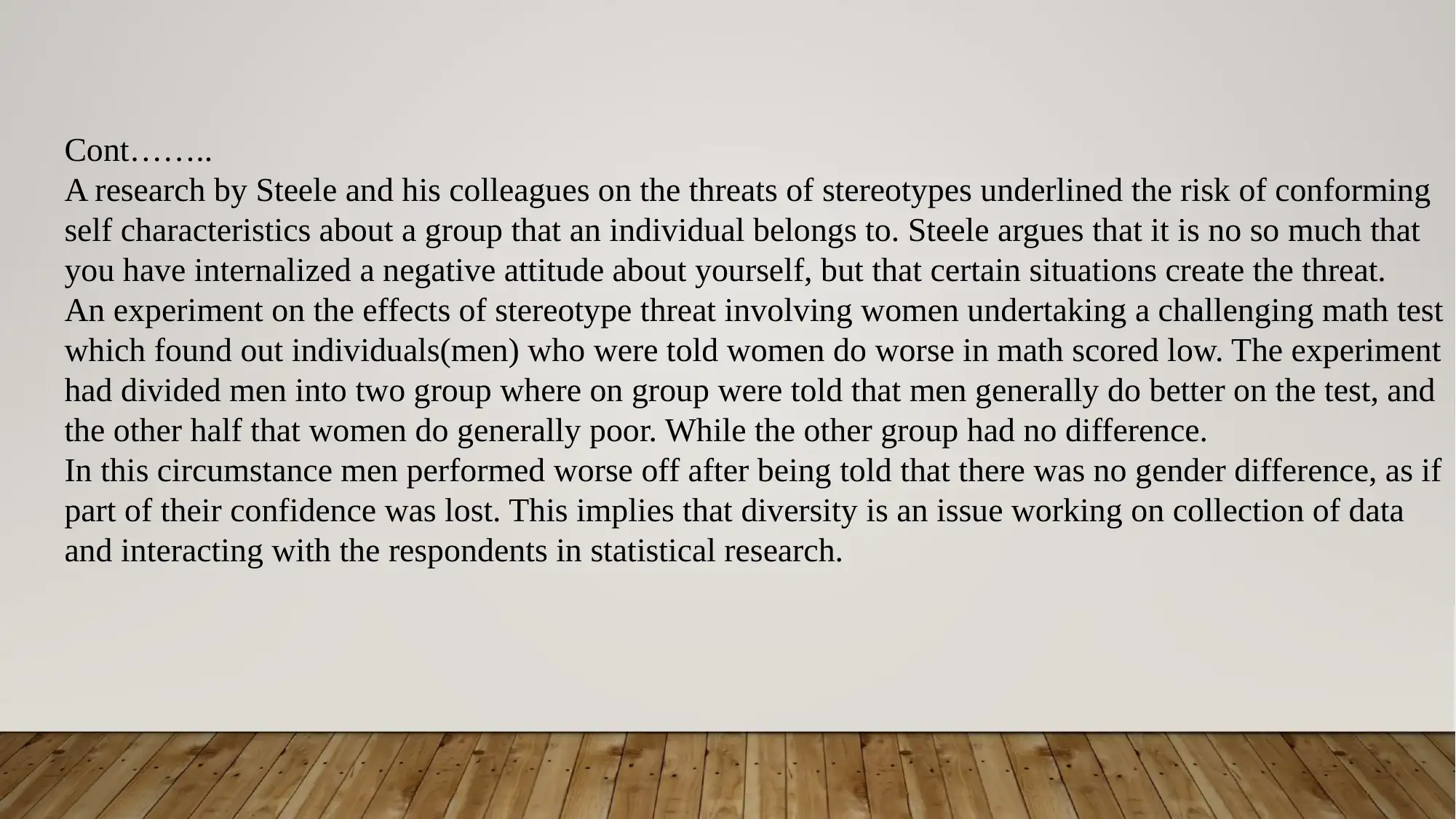
Cont……..
A research by Steele and his colleagues on the threats of stereotypes underlined the risk of conforming
self characteristics about a group that an individual belongs to. Steele argues that it is no so much that
you have internalized a negative attitude about yourself, but that certain situations create the threat.
An experiment on the effects of stereotype threat involving women undertaking a challenging math test
which found out individuals(men) who were told women do worse in math scored low. The experiment
had divided men into two group where on group were told that men generally do better on the test, and
the other half that women do generally poor. While the other group had no difference.
In this circumstance men performed worse off after being told that there was no gender difference, as if
part of their confidence was lost. This implies that diversity is an issue working on collection of data
and interacting with the respondents in statistical research.
A research by Steele and his colleagues on the threats of stereotypes underlined the risk of conforming
self characteristics about a group that an individual belongs to. Steele argues that it is no so much that
you have internalized a negative attitude about yourself, but that certain situations create the threat.
An experiment on the effects of stereotype threat involving women undertaking a challenging math test
which found out individuals(men) who were told women do worse in math scored low. The experiment
had divided men into two group where on group were told that men generally do better on the test, and
the other half that women do generally poor. While the other group had no difference.
In this circumstance men performed worse off after being told that there was no gender difference, as if
part of their confidence was lost. This implies that diversity is an issue working on collection of data
and interacting with the respondents in statistical research.
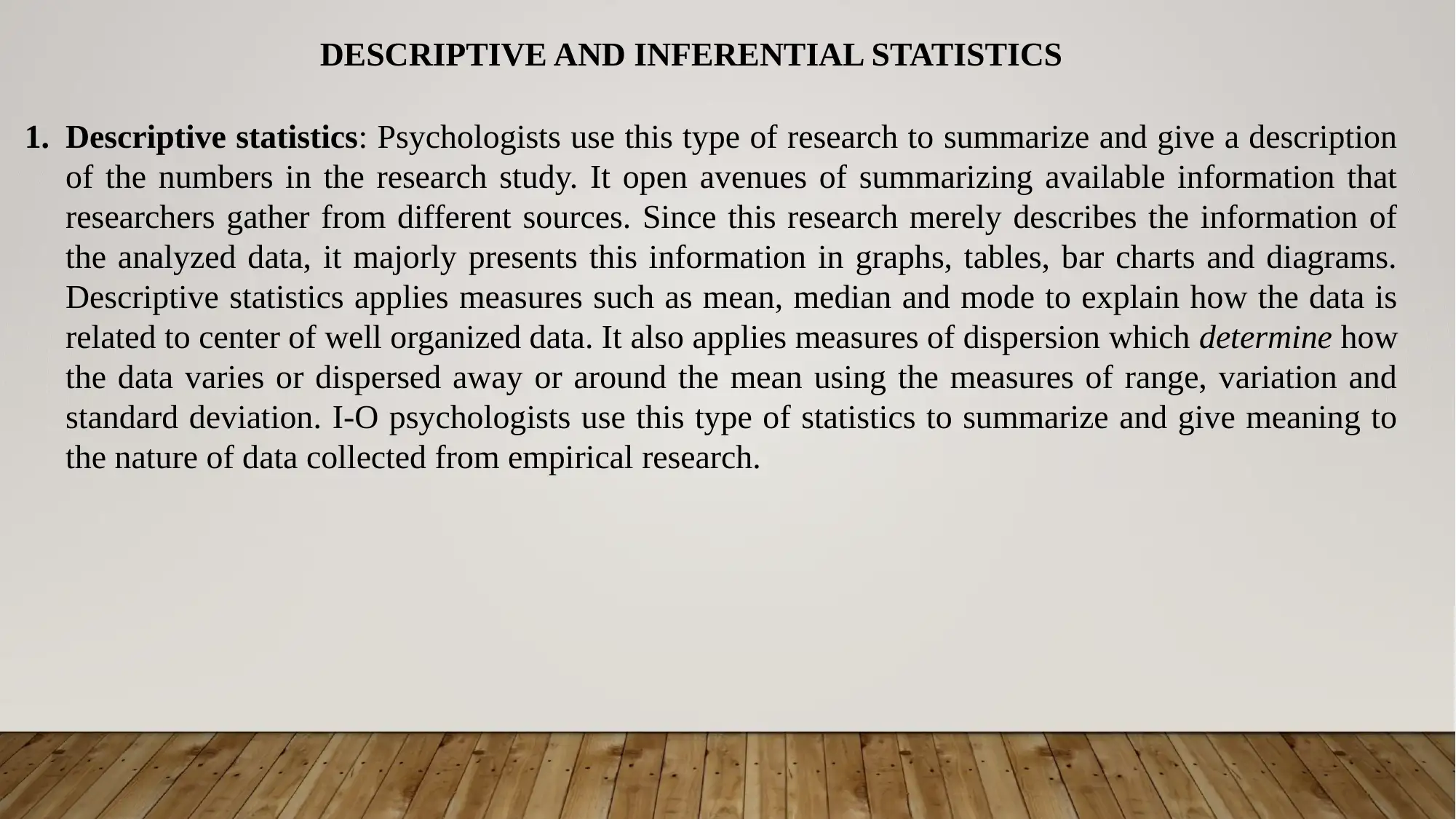
DESCRIPTIVE AND INFERENTIAL STATISTICS
1. Descriptive statistics: Psychologists use this type of research to summarize and give a description
of the numbers in the research study. It open avenues of summarizing available information that
researchers gather from different sources. Since this research merely describes the information of
the analyzed data, it majorly presents this information in graphs, tables, bar charts and diagrams.
Descriptive statistics applies measures such as mean, median and mode to explain how the data is
related to center of well organized data. It also applies measures of dispersion which determine how
the data varies or dispersed away or around the mean using the measures of range, variation and
standard deviation. I-O psychologists use this type of statistics to summarize and give meaning to
the nature of data collected from empirical research.
1. Descriptive statistics: Psychologists use this type of research to summarize and give a description
of the numbers in the research study. It open avenues of summarizing available information that
researchers gather from different sources. Since this research merely describes the information of
the analyzed data, it majorly presents this information in graphs, tables, bar charts and diagrams.
Descriptive statistics applies measures such as mean, median and mode to explain how the data is
related to center of well organized data. It also applies measures of dispersion which determine how
the data varies or dispersed away or around the mean using the measures of range, variation and
standard deviation. I-O psychologists use this type of statistics to summarize and give meaning to
the nature of data collected from empirical research.
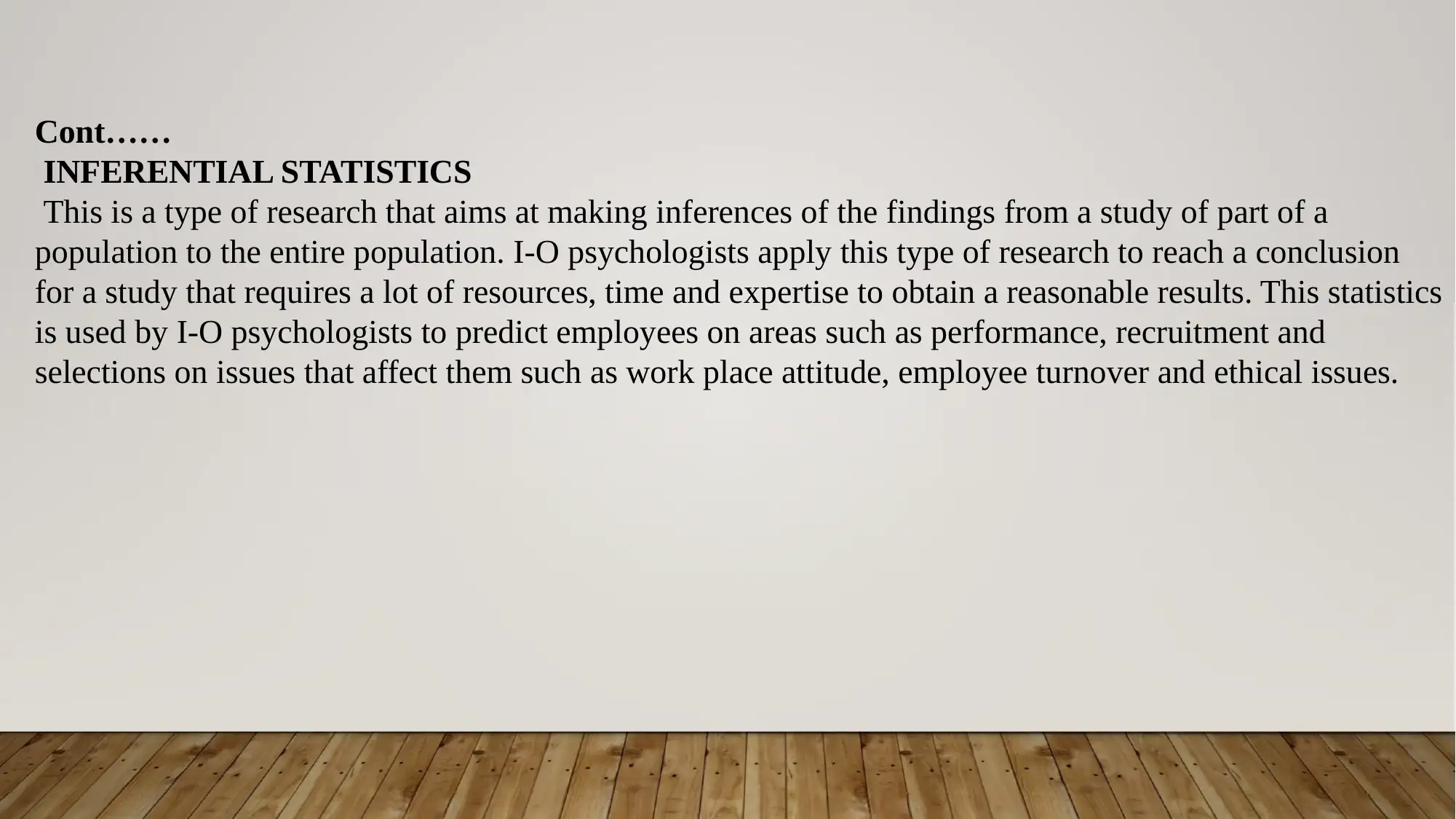
Cont……
INFERENTIAL STATISTICS
This is a type of research that aims at making inferences of the findings from a study of part of a
population to the entire population. I-O psychologists apply this type of research to reach a conclusion
for a study that requires a lot of resources, time and expertise to obtain a reasonable results. This statistics
is used by I-O psychologists to predict employees on areas such as performance, recruitment and
selections on issues that affect them such as work place attitude, employee turnover and ethical issues.
INFERENTIAL STATISTICS
This is a type of research that aims at making inferences of the findings from a study of part of a
population to the entire population. I-O psychologists apply this type of research to reach a conclusion
for a study that requires a lot of resources, time and expertise to obtain a reasonable results. This statistics
is used by I-O psychologists to predict employees on areas such as performance, recruitment and
selections on issues that affect them such as work place attitude, employee turnover and ethical issues.
Paraphrase This Document
Need a fresh take? Get an instant paraphrase of this document with our AI Paraphraser
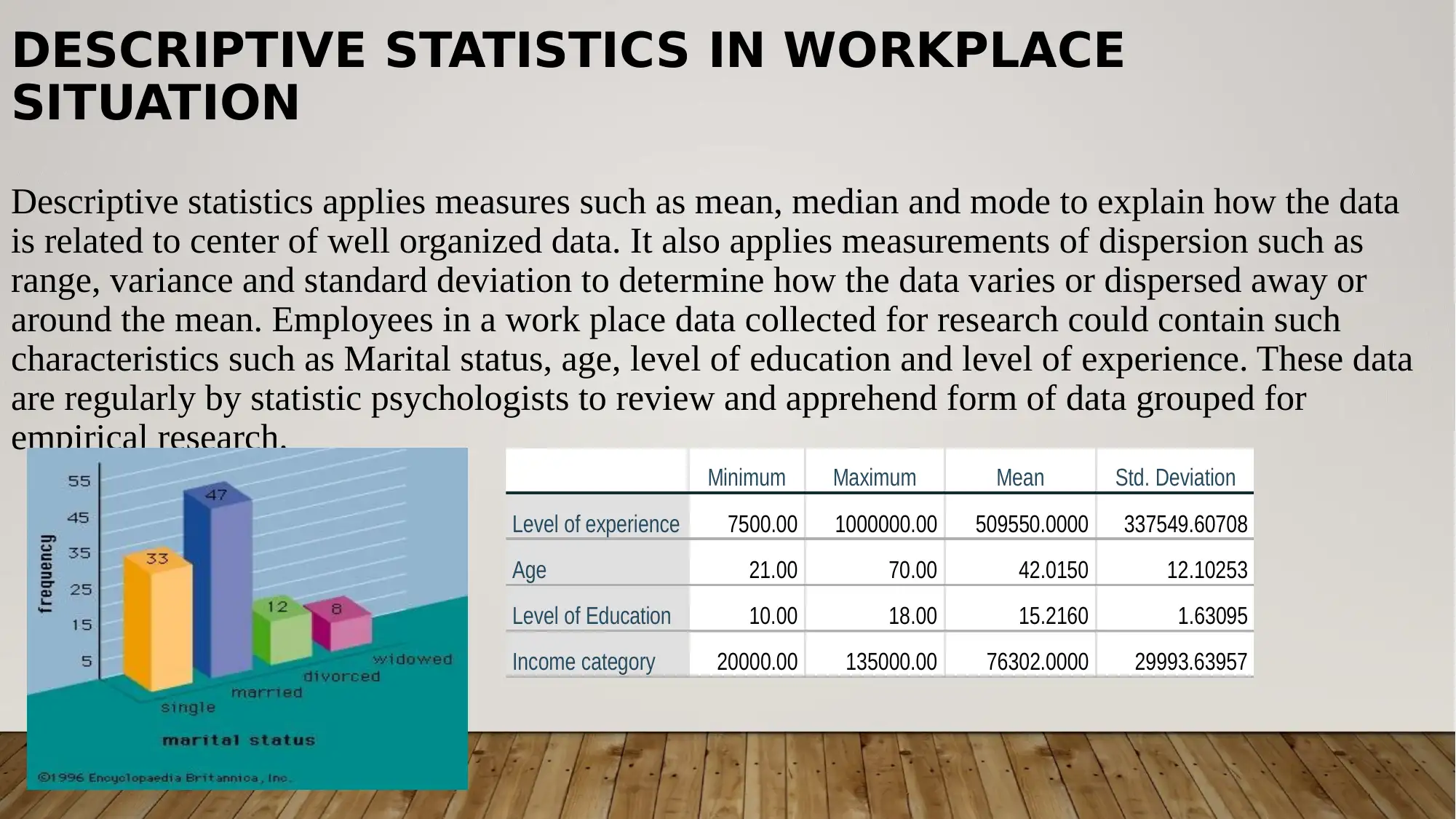
DESCRIPTIVE STATISTICS IN WORKPLACE
SITUATION
Descriptive statistics applies measures such as mean, median and mode to explain how the data
is related to center of well organized data. It also applies measurements of dispersion such as
range, variance and standard deviation to determine how the data varies or dispersed away or
around the mean. Employees in a work place data collected for research could contain such
characteristics such as Marital status, age, level of education and level of experience. These data
are regularly by statistic psychologists to review and apprehend form of data grouped for
empirical research.
Minimum Maximum Mean Std. Deviation
Level of experience 7500.00 1000000.00 509550.0000 337549.60708
Age 21.00 70.00 42.0150 12.10253
Level of Education 10.00 18.00 15.2160 1.63095
Income category 20000.00 135000.00 76302.0000 29993.63957
SITUATION
Descriptive statistics applies measures such as mean, median and mode to explain how the data
is related to center of well organized data. It also applies measurements of dispersion such as
range, variance and standard deviation to determine how the data varies or dispersed away or
around the mean. Employees in a work place data collected for research could contain such
characteristics such as Marital status, age, level of education and level of experience. These data
are regularly by statistic psychologists to review and apprehend form of data grouped for
empirical research.
Minimum Maximum Mean Std. Deviation
Level of experience 7500.00 1000000.00 509550.0000 337549.60708
Age 21.00 70.00 42.0150 12.10253
Level of Education 10.00 18.00 15.2160 1.63095
Income category 20000.00 135000.00 76302.0000 29993.63957
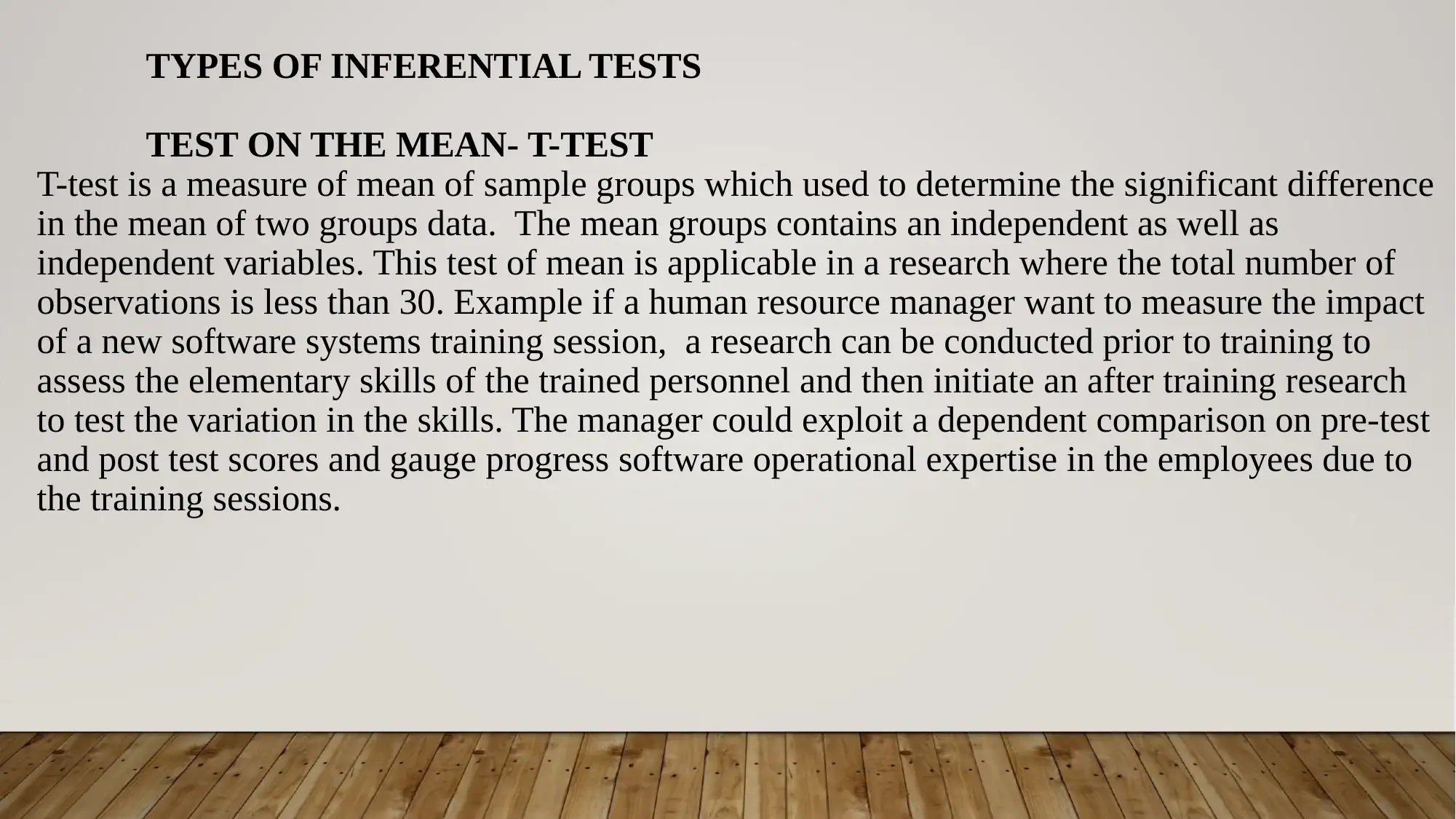
TYPES OF INFERENTIAL TESTS
TEST ON THE MEAN- T-TEST
T-test is a measure of mean of sample groups which used to determine the significant difference
in the mean of two groups data. The mean groups contains an independent as well as
independent variables. This test of mean is applicable in a research where the total number of
observations is less than 30. Example if a human resource manager want to measure the impact
of a new software systems training session, a research can be conducted prior to training to
assess the elementary skills of the trained personnel and then initiate an after training research
to test the variation in the skills. The manager could exploit a dependent comparison on pre-test
and post test scores and gauge progress software operational expertise in the employees due to
the training sessions.
TEST ON THE MEAN- T-TEST
T-test is a measure of mean of sample groups which used to determine the significant difference
in the mean of two groups data. The mean groups contains an independent as well as
independent variables. This test of mean is applicable in a research where the total number of
observations is less than 30. Example if a human resource manager want to measure the impact
of a new software systems training session, a research can be conducted prior to training to
assess the elementary skills of the trained personnel and then initiate an after training research
to test the variation in the skills. The manager could exploit a dependent comparison on pre-test
and post test scores and gauge progress software operational expertise in the employees due to
the training sessions.
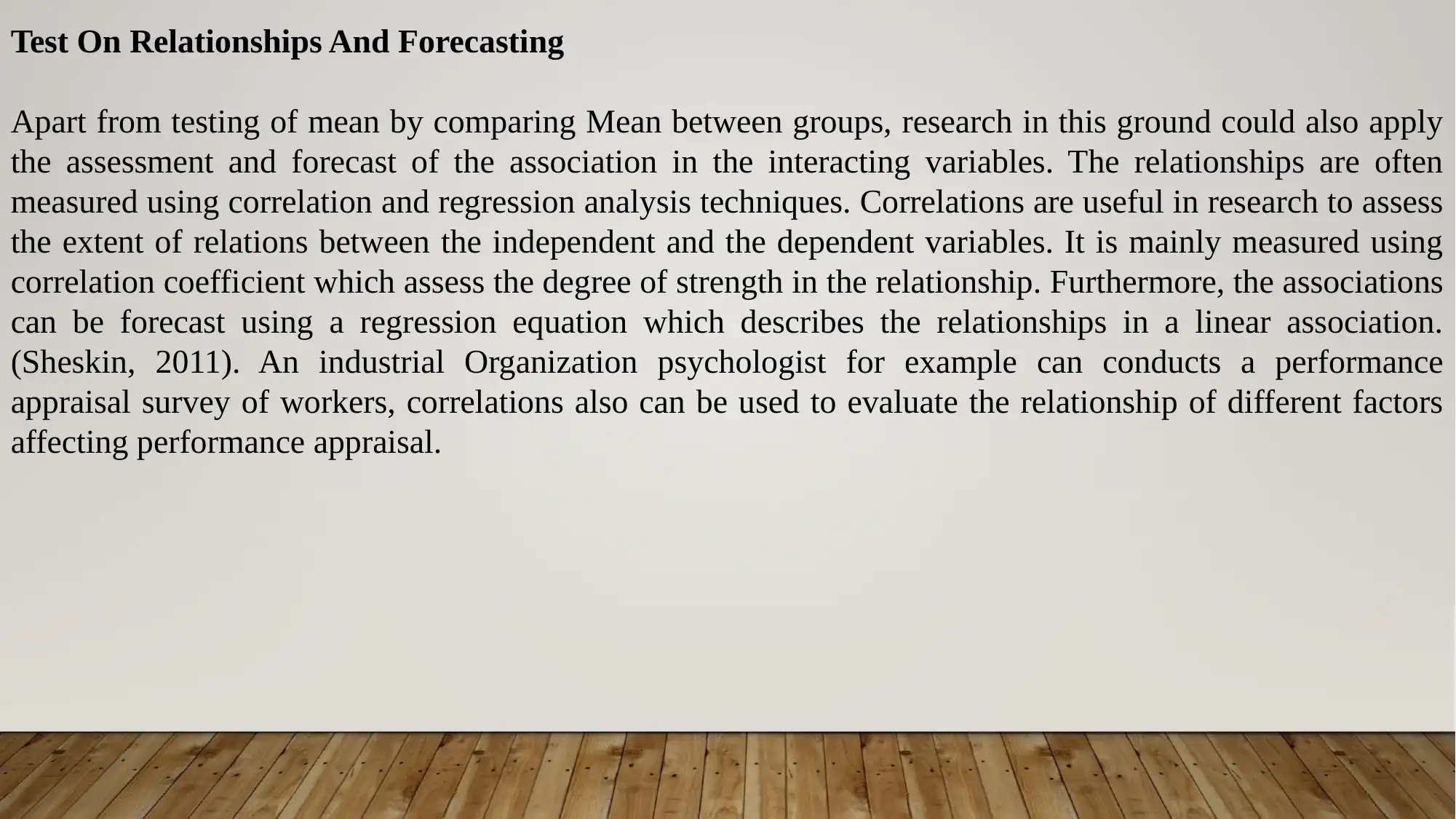
Test On Relationships And Forecasting
Apart from testing of mean by comparing Mean between groups, research in this ground could also apply
the assessment and forecast of the association in the interacting variables. The relationships are often
measured using correlation and regression analysis techniques. Correlations are useful in research to assess
the extent of relations between the independent and the dependent variables. It is mainly measured using
correlation coefficient which assess the degree of strength in the relationship. Furthermore, the associations
can be forecast using a regression equation which describes the relationships in a linear association.
(Sheskin, 2011). An industrial Organization psychologist for example can conducts a performance
appraisal survey of workers, correlations also can be used to evaluate the relationship of different factors
affecting performance appraisal.
Apart from testing of mean by comparing Mean between groups, research in this ground could also apply
the assessment and forecast of the association in the interacting variables. The relationships are often
measured using correlation and regression analysis techniques. Correlations are useful in research to assess
the extent of relations between the independent and the dependent variables. It is mainly measured using
correlation coefficient which assess the degree of strength in the relationship. Furthermore, the associations
can be forecast using a regression equation which describes the relationships in a linear association.
(Sheskin, 2011). An industrial Organization psychologist for example can conducts a performance
appraisal survey of workers, correlations also can be used to evaluate the relationship of different factors
affecting performance appraisal.
Secure Best Marks with AI Grader
Need help grading? Try our AI Grader for instant feedback on your assignments.
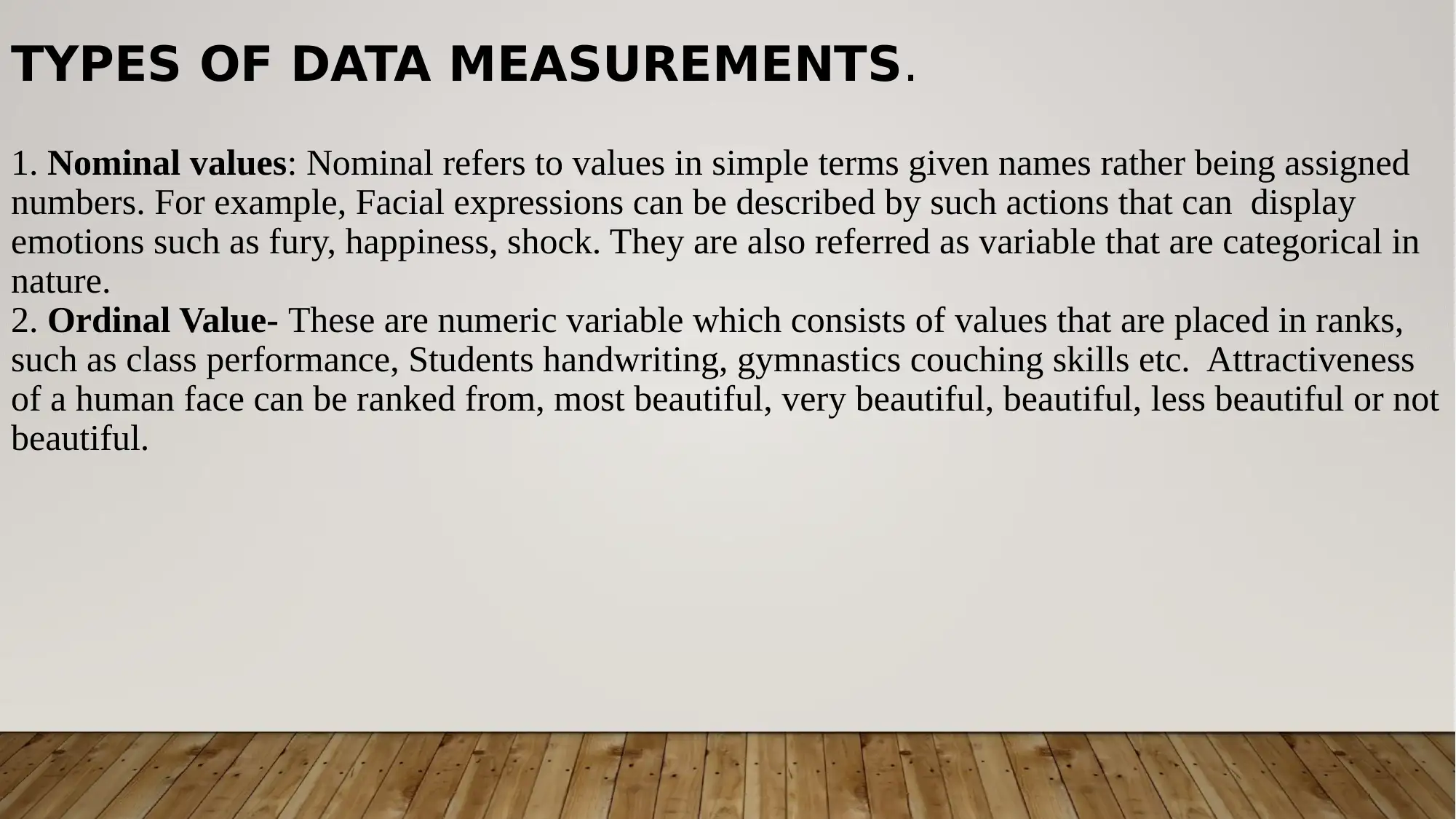
TYPES OF DATA MEASUREMENTS.
1. Nominal values: Nominal refers to values in simple terms given names rather being assigned
numbers. For example, Facial expressions can be described by such actions that can display
emotions such as fury, happiness, shock. They are also referred as variable that are categorical in
nature.
2. Ordinal Value- These are numeric variable which consists of values that are placed in ranks,
such as class performance, Students handwriting, gymnastics couching skills etc. Attractiveness
of a human face can be ranked from, most beautiful, very beautiful, beautiful, less beautiful or not
beautiful.
1. Nominal values: Nominal refers to values in simple terms given names rather being assigned
numbers. For example, Facial expressions can be described by such actions that can display
emotions such as fury, happiness, shock. They are also referred as variable that are categorical in
nature.
2. Ordinal Value- These are numeric variable which consists of values that are placed in ranks,
such as class performance, Students handwriting, gymnastics couching skills etc. Attractiveness
of a human face can be ranked from, most beautiful, very beautiful, beautiful, less beautiful or not
beautiful.
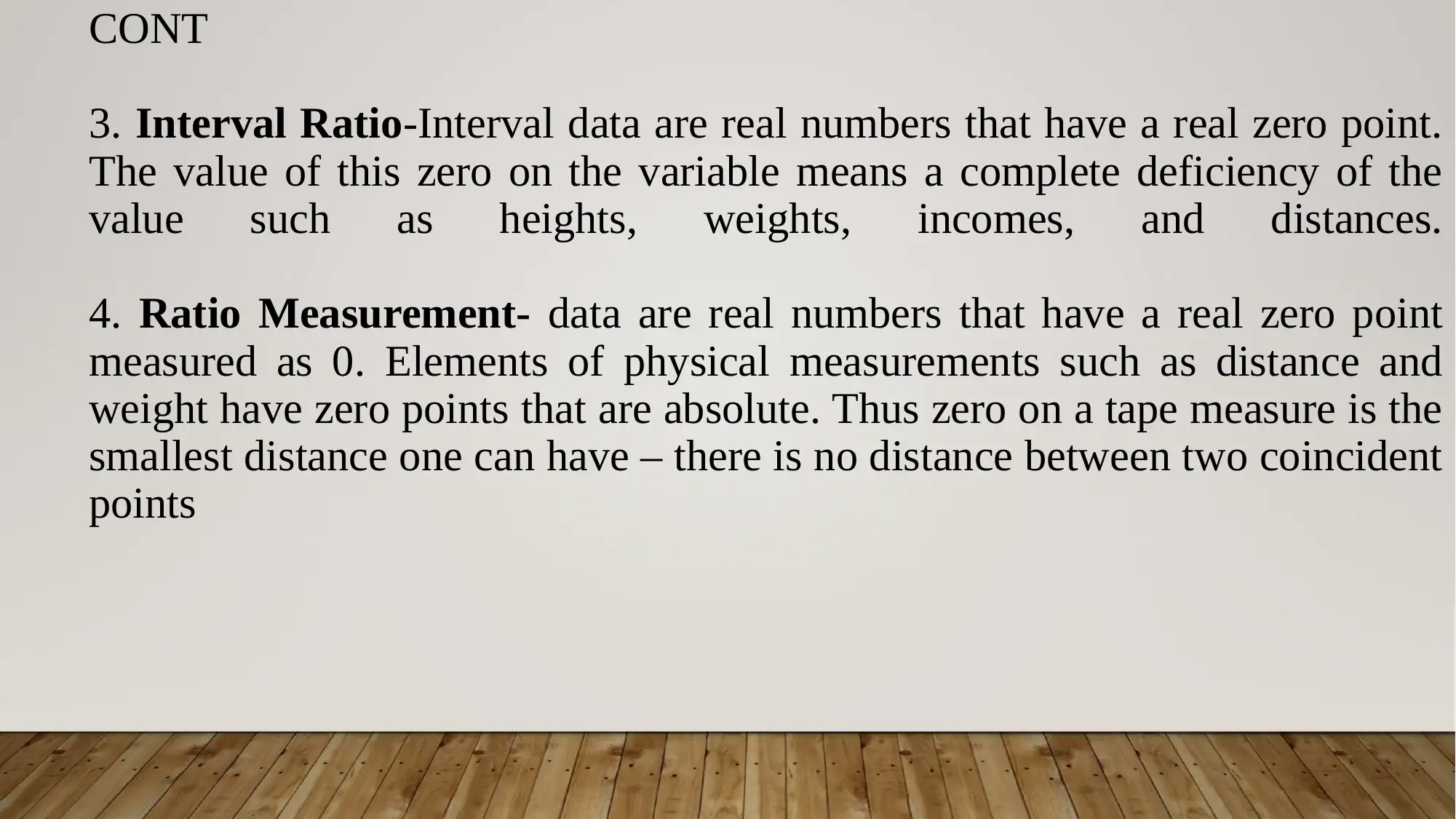
CONT
3. Interval Ratio-Interval data are real numbers that have a real zero point.
The value of this zero on the variable means a complete deficiency of the
value such as heights, weights, incomes, and distances.
4. Ratio Measurement- data are real numbers that have a real zero point
measured as 0. Elements of physical measurements such as distance and
weight have zero points that are absolute. Thus zero on a tape measure is the
smallest distance one can have – there is no distance between two coincident
points
3. Interval Ratio-Interval data are real numbers that have a real zero point.
The value of this zero on the variable means a complete deficiency of the
value such as heights, weights, incomes, and distances.
4. Ratio Measurement- data are real numbers that have a real zero point
measured as 0. Elements of physical measurements such as distance and
weight have zero points that are absolute. Thus zero on a tape measure is the
smallest distance one can have – there is no distance between two coincident
points
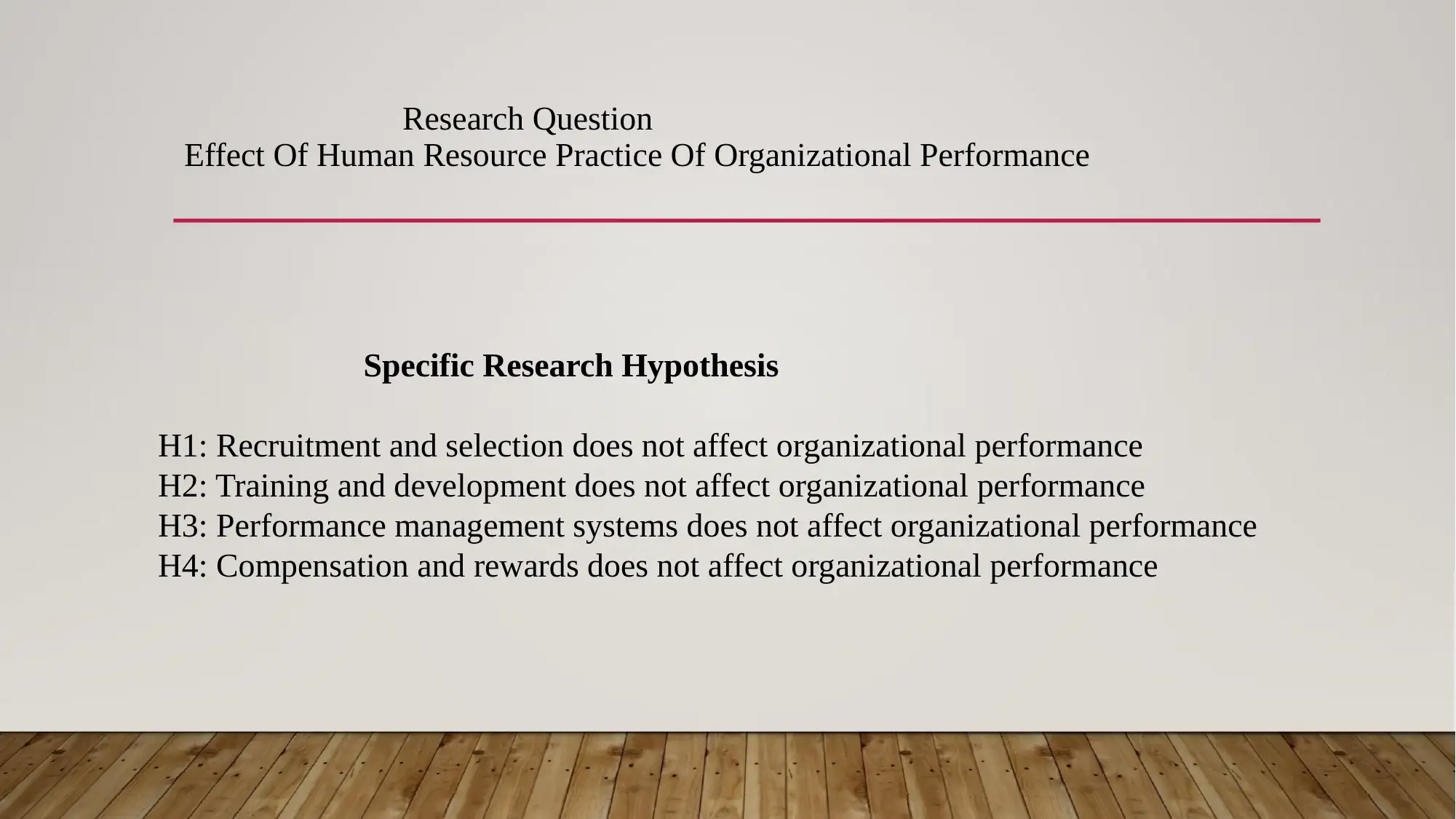
Research Question
Effect Of Human Resource Practice Of Organizational Performance
Specific Research Hypothesis
H1: Recruitment and selection does not affect organizational performance
H2: Training and development does not affect organizational performance
H3: Performance management systems does not affect organizational performance
H4: Compensation and rewards does not affect organizational performance
Effect Of Human Resource Practice Of Organizational Performance
Specific Research Hypothesis
H1: Recruitment and selection does not affect organizational performance
H2: Training and development does not affect organizational performance
H3: Performance management systems does not affect organizational performance
H4: Compensation and rewards does not affect organizational performance
Paraphrase This Document
Need a fresh take? Get an instant paraphrase of this document with our AI Paraphraser

THE VARIABLES MEASURED
The Research Has Two Variables; Independent And Dependent Variable
Dependent variable
Organizational Performance- it is measured using the following
customer satisfaction
Growth and market share
Profitability
leverage, liquidity and cash flow
Independent Variable
Human Resource Practices- it is measured using the following variables:
Recruitment and selection
Training and development
Performance management systems
Compensation and rewards
The Research Has Two Variables; Independent And Dependent Variable
Dependent variable
Organizational Performance- it is measured using the following
customer satisfaction
Growth and market share
Profitability
leverage, liquidity and cash flow
Independent Variable
Human Resource Practices- it is measured using the following variables:
Recruitment and selection
Training and development
Performance management systems
Compensation and rewards
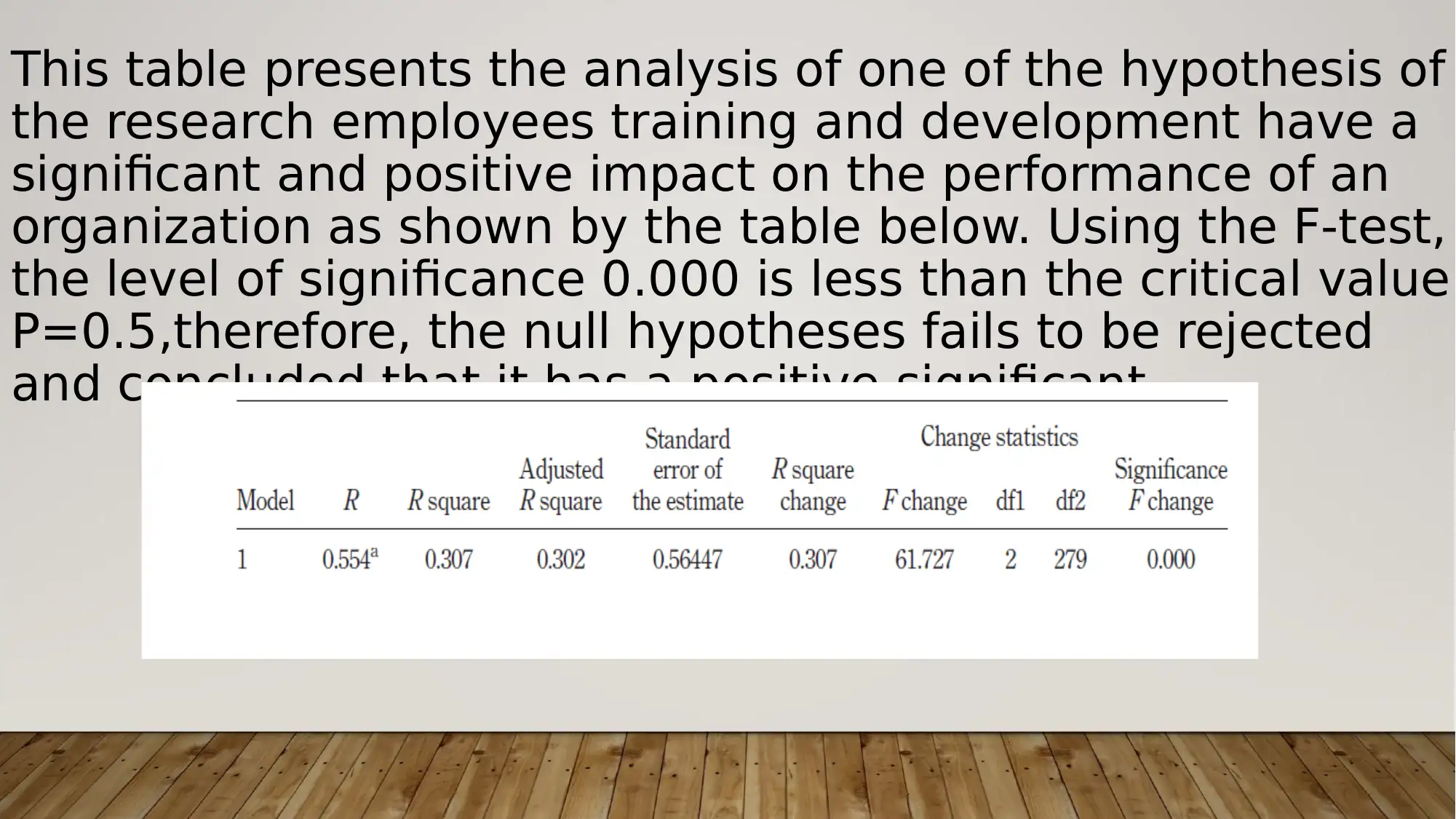
This table presents the analysis of one of the hypothesis of
the research employees training and development have a
significant and positive impact on the performance of an
organization as shown by the table below. Using the F-test,
the level of significance 0.000 is less than the critical value
P=0.5,therefore, the null hypotheses fails to be rejected
and concluded that it has a positive significant.
the research employees training and development have a
significant and positive impact on the performance of an
organization as shown by the table below. Using the F-test,
the level of significance 0.000 is less than the critical value
P=0.5,therefore, the null hypotheses fails to be rejected
and concluded that it has a positive significant.
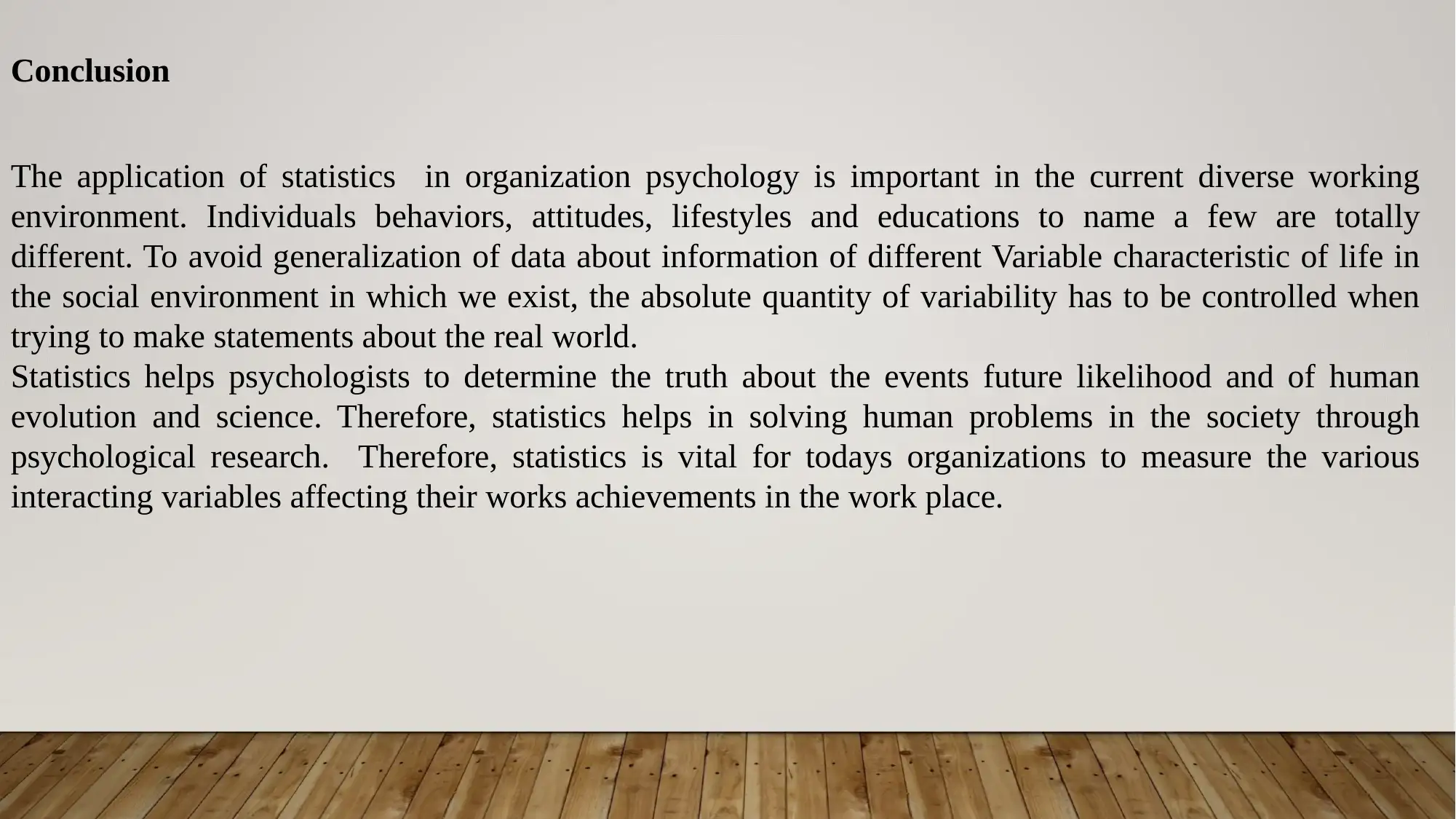
Conclusion
The application of statistics in organization psychology is important in the current diverse working
environment. Individuals behaviors, attitudes, lifestyles and educations to name a few are totally
different. To avoid generalization of data about information of different Variable characteristic of life in
the social environment in which we exist, the absolute quantity of variability has to be controlled when
trying to make statements about the real world.
Statistics helps psychologists to determine the truth about the events future likelihood and of human
evolution and science. Therefore, statistics helps in solving human problems in the society through
psychological research. Therefore, statistics is vital for todays organizations to measure the various
interacting variables affecting their works achievements in the work place.
The application of statistics in organization psychology is important in the current diverse working
environment. Individuals behaviors, attitudes, lifestyles and educations to name a few are totally
different. To avoid generalization of data about information of different Variable characteristic of life in
the social environment in which we exist, the absolute quantity of variability has to be controlled when
trying to make statements about the real world.
Statistics helps psychologists to determine the truth about the events future likelihood and of human
evolution and science. Therefore, statistics helps in solving human problems in the society through
psychological research. Therefore, statistics is vital for todays organizations to measure the various
interacting variables affecting their works achievements in the work place.
Secure Best Marks with AI Grader
Need help grading? Try our AI Grader for instant feedback on your assignments.
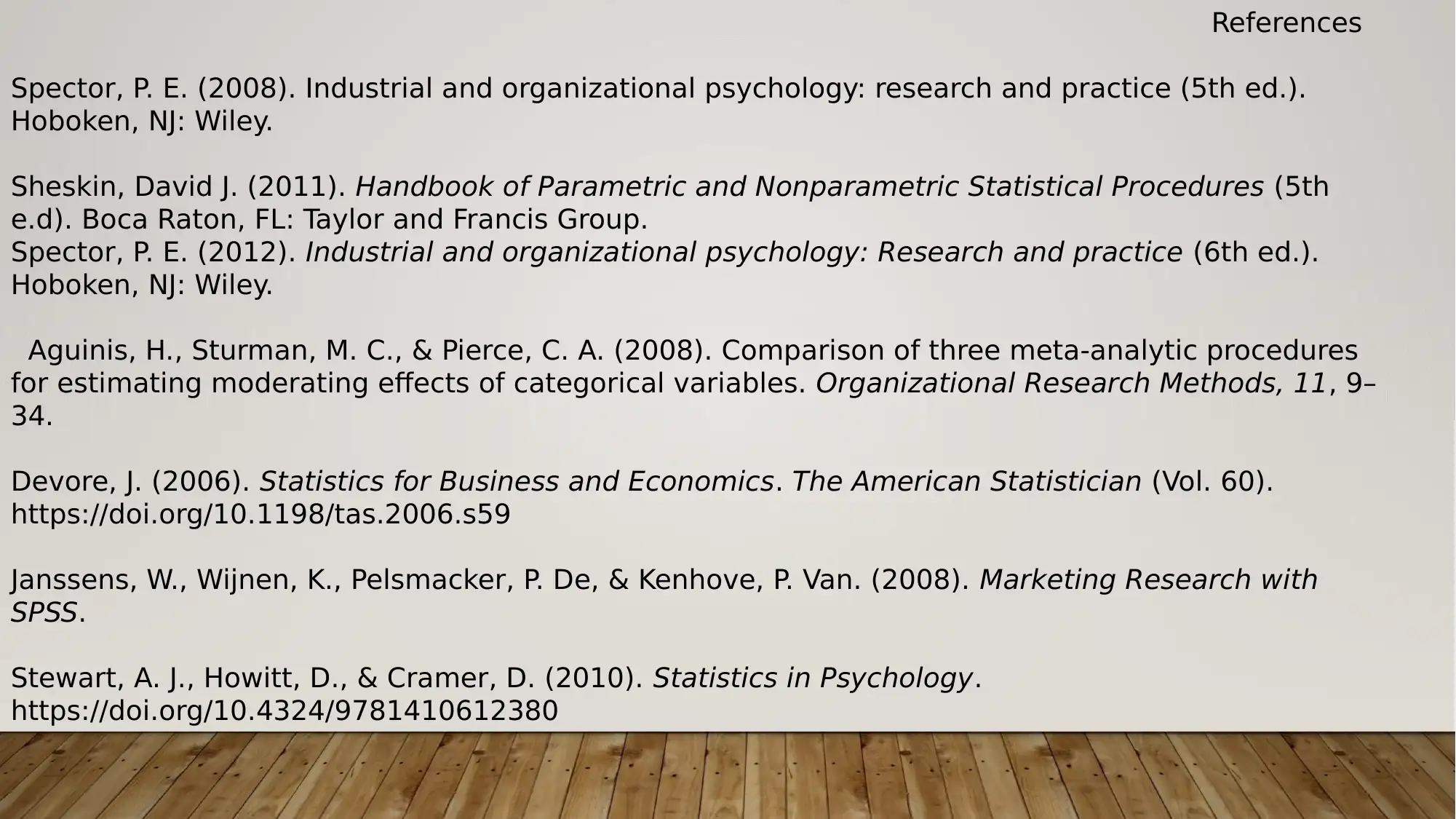
References
Spector, P. E. (2008). Industrial and organizational psychology: research and practice (5th ed.).
Hoboken, NJ: Wiley.
Sheskin, David J. (2011). Handbook of Parametric and Nonparametric Statistical Procedures (5th
e.d). Boca Raton, FL: Taylor and Francis Group.
Spector, P. E. (2012). Industrial and organizational psychology: Research and practice (6th ed.).
Hoboken, NJ: Wiley.
Aguinis, H., Sturman, M. C., & Pierce, C. A. (2008). Comparison of three meta-analytic procedures
for estimating moderating effects of categorical variables. Organizational Research Methods, 11, 9–
34.
Devore, J. (2006). Statistics for Business and Economics. The American Statistician (Vol. 60).
https://doi.org/10.1198/tas.2006.s59
Janssens, W., Wijnen, K., Pelsmacker, P. De, & Kenhove, P. Van. (2008). Marketing Research with
SPSS.
Stewart, A. J., Howitt, D., & Cramer, D. (2010). Statistics in Psychology.
https://doi.org/10.4324/9781410612380
Spector, P. E. (2008). Industrial and organizational psychology: research and practice (5th ed.).
Hoboken, NJ: Wiley.
Sheskin, David J. (2011). Handbook of Parametric and Nonparametric Statistical Procedures (5th
e.d). Boca Raton, FL: Taylor and Francis Group.
Spector, P. E. (2012). Industrial and organizational psychology: Research and practice (6th ed.).
Hoboken, NJ: Wiley.
Aguinis, H., Sturman, M. C., & Pierce, C. A. (2008). Comparison of three meta-analytic procedures
for estimating moderating effects of categorical variables. Organizational Research Methods, 11, 9–
34.
Devore, J. (2006). Statistics for Business and Economics. The American Statistician (Vol. 60).
https://doi.org/10.1198/tas.2006.s59
Janssens, W., Wijnen, K., Pelsmacker, P. De, & Kenhove, P. Van. (2008). Marketing Research with
SPSS.
Stewart, A. J., Howitt, D., & Cramer, D. (2010). Statistics in Psychology.
https://doi.org/10.4324/9781410612380
1 out of 17
Related Documents
Your All-in-One AI-Powered Toolkit for Academic Success.
+13062052269
info@desklib.com
Available 24*7 on WhatsApp / Email
![[object Object]](/_next/static/media/star-bottom.7253800d.svg)
Unlock your academic potential
© 2024 | Zucol Services PVT LTD | All rights reserved.





